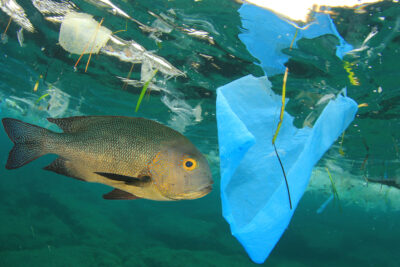

Erin Murphy is an intern at the International Marine Mammal Project of Earth Island Institute and a senior at the University of California, Berkeley.
This past month, 50 marine mammals washed up on U.K. shores, all with plastic in their stomachs. A striking amount of these animals were cetaceans -- whales, dolphins, or porpoises -- so the question is: how did all of them end up with the same fate?
Each year, an estimated 8 million tons of plastic enter the ocean, where it stays for decades, circulating within gyres and invading marine ecosystems across the globe. Scientists estimate that there are currently 15-51 trillion pieces of plastic clogging our oceans, leaving not a single square mile of surface ocean free of plastic. In fact, by 2050, pieces of plastic debris are predicted to outnumber all the fish in the sea.
This looming reality stems from the production of two types of plastic: macro and micro. Macroplastics are large, visible pieces of plastic, such as bags, straws, bottles, and containers. Microplastics are anything less than 5 mm long, about the size of a sesame seed. Some microplastics are combined in factories to create different types of products from plastics, and are commonly found in skin care products and other materials. Both kinds break down into smaller and smaller pieces, but neither fully degrades into the environment.
So where does this plastic end up once it meets the mouth of the ocean? Some of it follows the currents out to sea, and some of it gets washed back ashore, where it sits until something or someone moves it. A concerning amount of it, however, ends up in the stomachs of whales and dolphins. About 60% of stranded cetaceans worldwide have consumed plastic as of 2018, which means more than half of the population is at risk of death from this pollutant.
Cetaceans are vulnerable to encounters with plastic because their feeding methods range from filtering to hunting, and with such high amounts of plastic floating through their habitats, ingestion is almost inevitable. These animals are smart, and can generally tell the difference between plastic and food, but plastic can be deceptively appealing to the average cetacean eye or swallowed accidentally.
Microplastics sneak into whales’ mouths as they take huge gulps of seawater during filter feeding. Whales and dolphins that hunt accidentally capture plastic alongside their prey, and eat both. Prey, such as fish or squid, may already have consumed plastic themselves, which then transfer to the dolphin or whale that consumes them.
Once plastic enters the animal’s body, it accumulates and causes the creature to feel full. It can then no longer hunt and feed itself nutritious food. It ends up starving, leading to the sad sights of recent whales and dolphins on shore. Recent studies suggest that plastic may also contain bacteria and viruses that hinder the animal’s health. The plastic appears to act like a magnet, attracting toxic substances to its surface, thus adding the toxin(s) to the animal that consumes it.

Photo from Shutterstock.
It was in 2013 that microplastics were first identified in cetaceans, and since then, nearly every report has found them in deceased whales and dolphins. In 2016, scientists identified a population of fin whales that had become threatened by microplastic ingestion. Since early 2018, two sperm whales have been found with 79 combined pounds of plastic in their stomachs. And most recently, every cetacean washed ashore in the U.K. had plastic in its stomach.
The complete effects of plastic ingestion remain unknown, and it is not clear that plastic caused the deaths of these cetaceans. However, the fact that large amounts of plastic are being consumed by this many animals is deeply troubling.
Many whale and dolphin species are already threatened by whaling, entanglement in fishing nets and lines, climate change impacts, and capture for captivity, so the additional threat of plastic pollution is distressing. These animals cannot afford the loss of populations we are observing today, and because this is an anthropogenic impact, we need to take action.
Some cities and regions have already implemented bans on single-use plastics such as plastic bags, straws, and containers, and have even pledged to produce only completely recyclable materials within certain time frames. Costa Rica, for example, aims to eliminate all single-use plastics by the year 2021. The International Marine Mammal Project (IMMP) of Earth Island Institute encourages you to support local ordinances to ban use of plastics, especially single-use plastics. Plastic items made from alternative materials, such as corn starch, which breaks down after use, are a good substitute, as are cloth bags and old-fashioned waxed paper.
There are many ways to help reduce plastic pollution on the individual level. Join forces with the Earth Island Plastics Pollution Coalition or National Geographic’s Planet or Plastic? Campaign, which both aim to spread awareness and immediately reduce plastic pollution. Consider also using a resource such as Loop, an experimental program, which allows consumers to buy products and get refills in re-usable, durable containers.
Hopefully, with strict policies and with consumers taking action, we can help preserve our oceans and the whales and dolphins within them.
Photo of Whale Tail by Espen Bergesen.